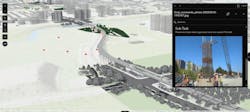Virtual design and construction approach is set to transform the delivery of rail transit infrastructure
Rail infrastructure projects are inherently complex and multi-phased, requiring collaboration across hundreds of engineers, designers and contractors, which can result in cost overruns and delays in schedule.
But it doesn’t need to be this way. A more unified, digital-led process can catalyze a significant leap forward for the progress and success of rail transit projects.
Two decades ago, Building Information Modeling (BIM) radically changed the building industry with the shift from two-dimensional blueprints to a virtual, collaborative environment for creating and delivering designs. Now, the next disruptive shift in the industry has arrived.
Uniting the design and construction phases of infrastructure projects within connected digital workflows, virtual design and construction (VDC) promises to activate a similar transformation. Designers, engineers, contractors, owners and operators in the rail industry have the opportunity to collectively embrace this approach to positively reshape how projects are designed and delivered.
Beyond the U.S. and Canada, an integrated digital approach from planning and design to operation and maintenance is already common. Internationally, the ISO 19650 standard is accelerating adoption of good information management and collaboration. It sets out a framework for exchanging information between a project’s parties throughout the asset lifecycle using BIM. For asset owners, this includes information management and guidance for the operational phase of an asset. However, this approach is not as widely adopted in North America for major rail projects relative to other regions. The regional rail projects employing VDC are realizing the benefits of this cohesive lifecycle process.
Transformation by unifying processes
As a centralized approach, VDC fully integrates disparate data and processes. It brings together diverse digital tools, creating a shared platform for project management and real-time collaboration across the entire lifecycle of a project. Integrating processes and multidisciplinary workflows in a single platform creates an environment of accessible data that can create a new level of communication across teams. This approach eliminates silos between contractors, engineers and agencies, cuts costly delays through real-time decision-making and strengthens accountability with shared, transparent data.
VDC can reduce costly errors and rework, accelerate project delivery by months or even years, improve passenger experience through better design and planning, and help agencies achieve more sustainable outcomes.
Collaborating across phases and teams
How does the digital methodology generate these outcomes in practice? Whereas traditional infrastructure design and construction are characterized by a linear flow of isolated activities, the linking capability of VDC changes how projects can be executed. This is especially important with progressive contracting models that rely on increased collaboration across project stakeholders.
An example of VDC in action is the Eglinton Crosstown West Extension in Toronto, a $4.7 billion expansion of Greater Toronto’s light-rail system being delivered with Metrolinx and Infrastructure Ontario. The project is split into four different contracts, each with its own procurement methodology and timeline, creating complex interfaces that, if not managed proactively, can risk schedule and cost overrun.
As the lead technical advisor to Metrolinx, Arup introduced Fuse, a centralized VDC-enabled platform that integrates geospatial and data analytics from multiple systems accessible through a single website—allowing users to login just once to the system. Fuse allows users to monitor construction progress, track requests for information and submittals and conduct mobile site inspections in real time.
Importantly, the toolset was built in close collaboration with Metrolinx, ensuring dashboards and KPIs directly support owner decision-making. As a result, weekly project meetings have shifted from reviewing static reports to interactive sessions where leaders can navigate live data, instantly identifying emerging risks and optimizing outcomes.
This level of collaboration—uniting contractors, engineers and agencies in a single digital ecosystem—illustrates VDC’s ability to create data continuity across phases, improve accountability and deliver more confident decision-making for large-scale transit projects.
Mitigating risks years in advance
VDC can quickly solve complex design problems and explore alternatives that would typically take months or that may not be entertained at all. By aggregating geospatial data—from design options to on-site investigation—into a project-wide digital environment, VDC workflows can help manage critical contract interface issues. This methodology is particularly effective for major infrastructure projects being delivered across multiple packages and contracts. Providing a live, integrated view across simultaneous but separate design efforts enables project teams to rapidly test design options, cross-check safety and performance and anticipate conflicts before they even reach the construction site.
For example, by comparing construction schedules against available site conditions and analyzing alternative configurations, Arup was able to identify a potential construction risk to the project that would have occurred in 2027. Uncovering the possible conflict early allowed the owner to proactively mitigate the risk, avoiding costly disruptions.
This same design agility can allow teams to pivot from suboptimal designs to faster, lower-cost alternatives validated through 4D modeling, where time is the fourth dimension of a 3D model.
By embedding this evaluative capability into day-to-day oversight, the Eglinton Crosstown West Extension has demonstrated how VDC can transform complex, multi-contractor infrastructure projects into coordinated efforts with reduced risk, better design outcomes and substantial time and cost savings.
Expanding design potential together
VDC is continually evolving, with new technologies that increase functionality and offer the capability to extend and expand the use of data throughout the entire lifecycle of a project. Even as a model amasses quantities of new information and tools over the course of a complex infrastructure project, the data remains accessible and visible, providing teams with the capacity to identify new approaches and challenge existing assumptions. With the increased incorporation of intelligent artificial intelligence-driven systems, VDC is poised to further advance how we design and build, bringing greater value to transportation infrastructure.
To unlock these transformational outcomes, engineers, designers, contractors, owners and operators must proactively come together to adopt a common digital methodology. The choice is clear: embrace VDC now to deliver rail projects that are not only on time but will perform better for decades to come.
About the Author

Jon Berkoe
Americas Digital Delivery Leader, Arup
Jon Berkoe is an associate principal at Arup based in San Francisco. He leads digital design delivery for major projects, harnessing the power of technology to achieve better outcomes for design, planning and construction.

Lindsay English
Americas Digital Rail Leader, Arup
Lindsay English is Arup’s Americas Digital Rail Leader based in Toronto. A seasoned technology leader, she combines her transportation and technology industry experience to bring digital solutions to rail infrastructure projects.
